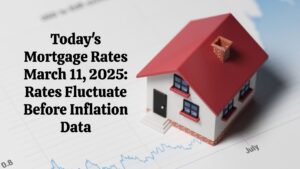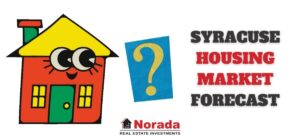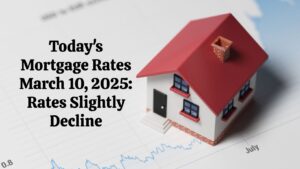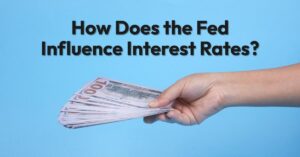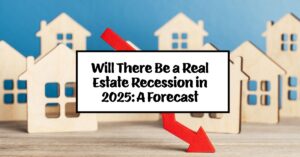As of March 12, 2025, mortgage and refinance rates show a small decrease, with the national average falling to 6.32% for 30-year fixed mortgages and 6.38% for refinancing. This trend comes amid economic concerns, as a struggling economy often influences interest rates. Understanding these dynamics can empower homebuyers and homeowners looking to refinance.
Today's Mortgage Rates March 12, 2025: Rates Drop Amid Economic Uncertainty
Key Takeaways
- Current Average Rates:
- 30-Year Fixed: 6.32%
- 15-Year Fixed: 5.60%
- 30-Year Refinance Rates: 6.38%
- Market Trends: Rates are lower this week due to ongoing economic uncertainty.
- Types of Mortgages:
- Fixed-rate mortgages offer stable monthly payments.
- Adjustable-rate mortgages (ARMs) introduce variable rates, which could lead to increased future payments.
Mortgage rates have been gradually falling in recent weeks, a combination of economic anxieties, including public worries about a potential recession. Historically, mortgage rates tend to drop when the economy is struggling, which can affect how lenders set their rates. If you are planning to buy a house or refinance an existing mortgage, understanding these rates and their implications is crucial.
Current Mortgage Rates on March 12, 2025
According to Zillow, here are today’s mortgage rates:
| Loan Type | Current Rate |
|---|---|
| 30-Year Fixed | 6.32% |
| 20-Year Fixed | 6.04% |
| 15-Year Fixed | 5.60% |
| 5/1 ARM | 6.30% |
| 7/1 ARM | 6.20% |
| 30-Year VA | 5.83% |
| 15-Year VA | 5.25% |
| 5/1 VA | 5.74% |
Today's Mortgage Refinance Rates
Today's refinance mortgage rates show slight variations, with rates typically being higher than those for purchasing a new home. Here are the latest average refinance rates:
| Refinance Type | Current Rate |
|---|---|
| 30-Year Fixed | 6.38% |
| 20-Year Fixed | 5.98% |
| 15-Year Fixed | 5.65% |
| 5/1 ARM | 6.58% |
| 7/1 ARM | 6.56% |
| 30-Year VA | 5.77% |
| 15-Year VA | 5.37% |
| 30-Year FHA | 5.85% |
| 15-Year FHA | 5.37% |
Understanding Mortgage Types and Their Implications
When considering a mortgage, it's essential to understand the different types available:
Fixed-Rate Mortgages
- 30-Year Fixed Mortgage: Offers the lowest monthly payment but leads to more interest paid over the life of the loan.
- 15-Year Fixed Mortgage: Higher monthly payments but lower total interest costs, with the loan paid off sooner.
Adjustable-Rate Mortgages (ARMs)
- 5/1 ARM: A fixed rate for the first five years, after which it can adjust annually based on market conditions. The initial interest rate is often lower, making it attractive if buyers plan to sell before rates reset.
- 7/1 ARM: Similar to the 5/1 ARM but with a seven-year fixed period. This is suitable for those looking for lower initial payments.
Both fixed and adjustable-rate mortgages have their pros and cons, depending on your financial situation and how long you plan to stay in your home.
Monthly Payment Calculations Under Current Rates
Understanding what your monthly mortgage payments would be at current rates is essential. Here’s how much you can expect to pay each month for various loan amounts with the current 30-year fixed mortgage rate of 6.32%.
Monthly Payment on a $150,000 Mortgage
At a 6.32% rate, your monthly payment would be approximately $935.56. This amount consists of the principal and interest, excluding additional costs such as insurance or property taxes.
Monthly Payment on a $200,000 Mortgage
If you take out a mortgage of $200,000, your expected monthly payment would hover around $1,247.41. It’s essential to remember that this payment can vary with changes in tax or insurance costs.
Monthly Payment on a $300,000 Mortgage
For a $300,000 mortgage, the monthly payment would average around $1,870.11, making it critical for buyers to assess their financial commitments and ability to make such payments.
Monthly Payment on a $400,000 Mortgage
If you're considering a $400,000 loan, your monthly payment would come to approximately $2,492.81. This notable figure highlights the importance of thorough financial planning and realistic budgeting.
Monthly Payment on a $500,000 Mortgage
Lastly, a $500,000 mortgage would require a monthly payment of about $3,115.51. This significant commitment underlines the necessity of understanding all variables involved in home buying.
Recommended Read:
Mortgage Rates Trends as of March 11, 2025
Mortgage Rates Drop: Can You Finally Afford a $400,000 Home?
Mortgage Rates Forecast March 2025: Will Rates Finally Drop?
Expect High Mortgage Rates Until 2026: Fannie Mae's 2-Year Forecast
The Broader Economic Context
The decline in mortgage rates could be interpreted as a reflection of investor concern regarding an impending recession. Investors are worried that tariffs might hurt the economy, and President Trump acknowledged that his policies could lead to a recession. Should a recession occur, mortgage rates are expected to decline.
Secondly, there's concern about stagflation – a scenario of high inflation paired with slow economic growth. In this case, the direction of mortgage rates will hinge on the Federal Reserve's response. The Fed has consistently stated its commitment to reducing inflation to 2%. Therefore, a rise in inflation could prompt the Fed to raise interest rates, which would likely push mortgage rates higher.
Different factors, such as inflation rates, employment statistics, and changes in the Federal Reserve's policies, play crucial roles in shaping mortgage rates. When the economy is performing well, rates tend to rise in anticipation of future growth. Conversely, during times of uncertainty, rates generally decline as lenders adjust to potential risks.
Borrowers are cautioned to consider the economic indicators that can impact future rates. For instance, if inflation rises, the Federal Reserve's response might be to increase interest rates, which could lead to higher mortgage rates in the future. Keeping an eye on these trends can be beneficial for making informed decisions.
The Importance of Shopping Around for Rates
Not all lenders offer the same rates or terms, which underscores the importance of shopping around. A small difference in interest rates can translate into substantial savings over the life of a loan. It's advisable to compare not just interest rates, but also fees associated with obtaining a mortgage. Always ask lenders for a breakdown of costs and clarify any points of confusion.
Conclusion
Understanding current mortgage and refinance rates is crucial for anyone considering a home purchase or looking to refinance. The trends we're seeing today reflect broader economic concerns, and staying informed can help borrowers make educated financial decisions.
As we've outlined, today's mortgage rates provide opportunities for homebuyers, particularly in a declining rate environment, but they also necessitate careful consideration of personal financial circumstances and economic factors that may affect future scenarios.
Work With Norada, Your Trusted Source for
Real Estate Investments
With mortgage rates fluctuating, investing in turnkey real estate
can help you secure consistent returns.
Expand your portfolio confidently, even in a shifting interest rate environment.
Speak with our expert investment counselors (No Obligation):
(800) 611-3060
Recommended Read:
- Mortgage Rate Predictions 2025 from 4 Leading Housing Experts
- Mortgage Rates Forecast for the Next 3 Years: 2025 to 2027
- 30-Year Mortgage Rate Forecast for the Next 5 Years
- 15-Year Mortgage Rate Forecast for the Next 5 Years
- Why Are Mortgage Rates Going Up in 2025: Will Rates Drop?
- Why Are Mortgage Rates So High and Predictions for 2025
- Will Mortgage Rates Ever Be 3% Again in the Future?
- Mortgage Rates Predictions for Next 2 Years
- Mortgage Rate Predictions for Next 5 Years
- Mortgage Rate Predictions: Why 2% and 3% Rates are Out of Reach
- How Lower Mortgage Rates Can Save You Thousands?
- How to Get a Low Mortgage Interest Rate?
- Will Mortgage Rates Ever Be 4% Again?


